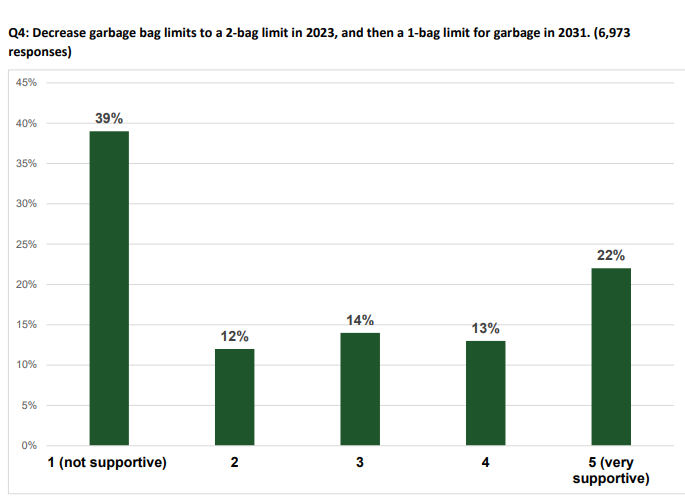Public opposition is forcing the region to reconsider a proposal to limit households to two garbage bags per biweekly pickup.
The idea was part of a new waste management strategy aiming to reduce Halton’s garbage and extend the lifespan of the region’s landfill.
The initial vision was for a two-bag limit beginning in 2023, with a one-bag limit in 2031.
But more than half of the nearly 7,000 Halton residents who responded to a regional survey said they didn’t support the decrease.
Only 22 per cent of respondents said they were very supportive of the idea.

Those opposed expressed concerns that a reduction would lead to more dumping in rural areas or public garbage cans.
They also worried about the impact of the reduction on large families and on households needing to dispose of diapers or pet waste.
Oakville councillor Sean O’Meara echoed those concerns at a meeting on May 25.
"I just don’t want to paint every household with the same brush here and say you should all fit in two bags of garbage and eventually only one bag of garbage," he said.
With an increase in multi-generational households, O’Meara suggested that a per person garbage limit might be something to consider.
Reducing the bag limit will be reviewed as the region moves forward with its waste management strategy.
The strategy aims to increase waste diversion – the amount of garbage diverted from landfills to recycling or composting – from its current plateau of about 59 per cent to 65 per cent by 2030 and 68 per cent by 2035.
That "lofty goal" is achievable, Rob Rivers, director of waste management, told Halton councillors. But he said a reduced bag limit is "critical" to help achieve waste diversion and minimization goals.
Reducing the garbage limit will encourage residents to divert blue box and organic food material currently going out with the trash, he noted.
Rivers added that about 80 per cent of Halton households already only put out two bags per pickup.
Under current conditions, the region’s Highway 25 landfill is expected to reach capacity between 2040 and 2044. The new strategy aims to extend its life by an additional five years.
Finding a new landfill site was estimated to cost about $800 million in 2011 when the region last costed the idea.
Clear bags to track trash?
Councillor Allan Elgar questioned whether the region should force residents to put garbage in clear bags, so trash can be rejected if it contains material that could be diverted.
That approach has been adopted by Markham, with apparent success in improving diversion rates.
"It’s not the most popular thing in the beginning, but it brings people around in a short period of time," said Elgar.
Rivers noted that while the region may eventually need to introduce bylaws, fines or other "sticks," it is currently focused on "carrots" to encourage compliance.
"We know the citizens of Halton are very environmentally focused," he said. "We want them to do it on their own."
Other initiatives in the $4.6 million strategy include:
- Launching a pilot project in early 2023 to investigate wheeled carts for automated collection of garbage, recyclable material and organic waste.
- Establishing new permanent waste drop-off depots near high-density urban areas to reduce travel time for residents dropping off recyclables, organics, garbage and yard waste.
- Diverting textiles and other designated materials from landfill through reuse and recycle programs, with materials handled by a third party or charitable organization.
- Support, partner with and partially fund organizations involved in the sharing economy, including tool libraries and repair cafes.
- Improve waste diversion in multi-residential buildings.
While regional politicians have endorsed the overall strategy, further reports and decisions will be made on the individual elements as detailed plans for implementation are developed.